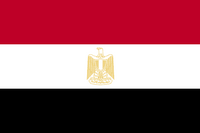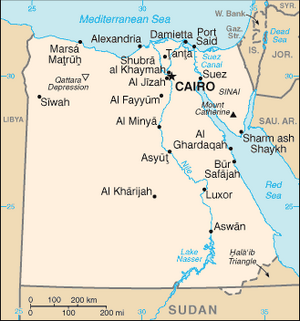| The Arab Republic of Egypt |
|---|
| Flag: |
| Location: |
| Capital: Cairo |
| Official Language: Arabic |
| Government: Semi-presidential republic |
| Head of State: President Ahmed Nazif |
| Formation: c.3150 BC |
| Population: 81,713,517 (July 2008) |
| Currency: Egyptian pound |
| ¨Human Rights Record¨ Wikipedia article |
| ¨Territorial Disputes¨ Hala'ib Triangle between Sudan and Egypt read more and the Wadi Halfa also concerning a conflict with Sudan read more |
| ¨Ongoing Conflicts¨ (If any) |
Welcome to the international embassy of Egypt! The people of Egypt welcome all peoples and nations with open arms and hope to have robust and productive relations with all who wish them.
Diplomatic Relations[]
Nation currently enjoys diplomatic relations with
Algeria, Argentina, Austrailia, Bangladesh, Belarus, Belgium, Brazil, Canada, Chile, China (PR), Colombia, Cuba, Czech Republic, DR Congo, Denmark, El Salvador, Ethiopia, Finland, France, Georgia, Germany, Ghana, Greece, Hungary, India, Indonesia, Iran, Iraq, Ireland, Israel, Italy, Japan, Kazakhstan, Korea, North, Korea, South, Kuwait, Libya, Malaysia, Mexico, Morocco, Netherlands, Nigeria, Norway, Pakistan, Palestine (PLO), Panama, Paraguay, Peru, Philippines, Poland, Portugal, Romania, Russia, Saudi Arabia, South Africa, Spain, Sudan, Sweden, Syria, Tunisia, Turkey, Ukraine, United Kingdom, United States, Venezuela, Vietnam.
Nation is a member of
The League of Arab States,
The Organization of Islamic Conference,
La Fracophonie,
The African Union,
The Non-Aligned Movement,
The World Trade Organization
and the United Nations.
Nation is a signatory to the following treaties (list)
//We will do this bit later, just have the template up so we can do it.
Summary[]
Egypt (Arabic: مصر, Miṣr or Máṣr) is a country in North Africa, with the Sinai Peninsula forming a land bridge to Western Asia. Covering an area of about 1,001,450 square kilometers (386,660 sq mi), Egypt borders the Mediterranean Sea to the north, the Gaza Strip and Israel to the northeast, the Red Sea to the east, Sudan to the south and Libya to the west.
Egypt is one of the most populous countries in Africa and the Middle East. The great majority of its estimated 80 million live near the banks of the Nile River, in an area of about 40,000 square kilometers (15,000 sq mi), where the only arable agricultural land is found. The large areas of the Sahara Desert are sparsely inhabited. About half of Egypt's residents live in urban areas, with the majority spread across the densely-populated centres of greater Cairo, Alexandria and other major cities in the Nile Delta.
Egypt is famous for its ancient civilization and some of the world's most famous monuments, including the Giza pyramid complex and its Great Sphinx. The southern city of Luxor contains numerous ancient artifacts, such as the Karnak Temple and the Valley of the Kings. Egypt is widely regarded as an important political and cultural nation of the Middle East.
Brief History[]
The regularity and richness of the annual Nile River flood, coupled with semi-isolation provided by deserts to the east and west, allows for the development of one of the world's great civilizations. A unified Kingdom of Egypt arises circa 3200 BC and a series of dynasties ruled in Egypt for the next three millennia. Egypt is conquered by Persia in 525 BC, that rules Egypt until 404 BC, when it regains independence. Persia recaptures Egypt in 343, but in 332 BC Egypt is incorporated into Macedon. After the division of the Macedon Empire in 310 BC, Egypt becomes the basis of the Ptolemaic Empire. Egypt is incorporated into the Roman Empire in 51 BC as a protectorate in which the Ptolemaics remain in office. When the Roman Empire is divided in 395, Egypt becomes part of the East Roman Empire. From 636 Egypt is conquered by the Caliphate, but it becomes an independent Arab state in 878. It are the Arabs who introduce islam and the Arabic language in the 7th century and who rule for the next six centuries. Since 969 Egypt is ruled by the Fatimides who establish the Caliphate of Cairo. This caliphate controls large parts of the middle east and is ruled by the Ebujides from 1181 A local military caste, the Mamluks takes control about 1250.
In 1517 the Caliphate becomes part of the Ottoman Empire incorporates and annexes the caliphate in 1517. The Mamluks dynasty continues to govern after the conquest. Between 1798 and 1801 Egypt is occupied by France and from 1801 until 1806 by Britain. In 1806 Egypt becomes de facto independent. It is restyled the Khediviate of Egypt in 1841, but remains under Ottoman suzerainty. In 1882 Britain occupies the country and though it still remains under Ottoman suzerainity, de facto it becomes a British colony. In 1914 Britain eliminates the Ottoman suzerainity and Egypt becomes a sultanate under British protectorate, named Egyptian Sultanate and renamed Kingdom of Egypt in 1922. The Kingdom of Egypt is officialy independent, but British supervision remains until 1946.
Egypt has a parliamentary government, though real power is held by the king. The main political party is the al Wafdu al Misrî (Egyptian Delegation, Wafd). Its leader, Saad Zaghlul Pasha, becomes prime minister in 1924, when Wafd had won the parliamentary elections. After his death in 1927 he is succeeded by Mustafa an-Nahas Pasha. King Fuad sacks Nahas Pasha in 1931 and suspends the constitution of 1923. After elections in 1936 Wafd is returned to power, but after tensions between the party and the new king Faruk, Nahas Pasha is dismissed again. Britain forces the king in 1942 to re-appoint Nahas Pasha as prime minister (until 1944). In 1950 Wafd wins the parliamentary elections, bringing Nahas Pasha to the premiership again and the party is becoming increasingly anti-British. The king dismisses the Wafd government in 1952, following riots in Cairo.
That year the army stages a coup and in 1953 the monarchy is abolished. Egypt is renamed Republic of Egypt and Ali Muhammad Nagib becomes president. In 1954 Gamal Abd al Nasir (better known as Nasser) makes himself dictator and establishes a one-party state under the National Union. Egypt merges with Syria in 1958 into the United Arab Republic. The United Arab Republic remains a dictatorship and when the government dissolves the Syrian regional executive, Syria secedes from the United Arab Republic and establishes the Syrian Arab Republic. The Egyptian part keeps the name United Arab Republic until 1971. When Nasser dies in 1970, he is succeeded by Muhammad Anwar al-Sadat. He renames the country in 1969 Arab Republic of Egypt. Sadat rules Egypt as a one-party state under the Arab Socialist Union. He is assasinated in 1981 and is succeeded by Muhammad Husni Mubarak. Mubarak reorganizes the Arab Socialist Union into the Hizb al Dimuqratiyah al Wataniyah (National Democratic Party, HDW) and allows a controlled multi-party system in a democratic facade, in which he and his party win all elections.
On New Years eve 2008 President Mubarak was attending the celebrations taking place in Alexandria along the key side. At 00.15 after the countdown President Mubarak took to the stage to begin his New Year adress to the people, after around 30 seconds 4 shots were heard and panic ensued. As the assembled crowd of revelers fled the President was thrown into the Presidential limo which sped away. On the opposite side of the river a motor boat could be seen to speed away out to see.
By 03.30 the all state medias stations were reporting that President Mubarak was in hospital, mortally wounded, with the panic that followed it was decided that a press conference must be held at the hospital to reassure people and prevent any moves by the Muslim Brotherhood and any other subverssive elements.
At 04.15 Prime Minister Ahmed Nazif stood before the throngs of assembled camera men and journalists and declared that the President was alive and was at no risk. PM Nazif reported that President Mubarak had suffered a bullet wound to the upper arm and had been treated accordingly but was being kept in for observtion due to his age, but would hold a press conference in the morning.
At 09.30 on new years day President Hosni Mubark took to the stage again, this time in a sling and began to reassure the nation that those who attempted to assisnate him and endangered so many people would be hunted down. In mid sentence one of the stage lights broke off from its ties and struck President Mubarak square on the temple. In scenes similar to the evening the President was rushed to hospital once again. At approximatly 11.15, PM Ahmed Nazif emerged from the hospital and made the somber announcement that the President had suffered massive head trauma and had died on the operating table.
Within hours an emergency meeting with heads of all minitries, the military and the judiciary took place and the decision was made that Prime Minister Ahmed Nazif would be inaugurated as President in accordance with his position as Head of the govenrment. At an emergency session of the People's Assembly a vote of confidence and approval was made on the inaguration of Nazif. The National Democratic Party then put forward its deptuy leader, Abdul Husn Bakhir who was given a vote of confidence and approval for him to become the new Prime Minister.
Diplomatic Messages[]
Foreign Ministry letter to all airlines operating in Egypt, 12,06,2009.
We advise all airlines to ensure that any flights travelling to Kuwait during this current political climate check that their arrival is expected by Kuwaiti Air Traffic control and that they inform them of their approach to the countries borders and upon their approach to the airport. Should a plane loose radio communications it is advised to return to Egypt or cooperate with Kuwaiti attempts to land them in a safe area.
Foreign Ministry Memo to Embassy in Kuwait City, 25/07/2009.
With the closure of the Vietnamese embassy in Kuwait City and the refusal of the Emir to allow Vietnamese planes into Kuwait to evacuate Vietnamese civilians the PM has decided to allow Vietnamese civilians to be safely moved out of Kuwait under diplomatic status.

